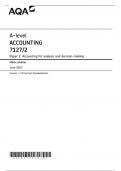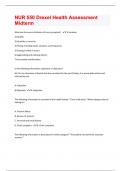Exam (elaborations)
AQA A LEVEL ACCOUNTING PAPER 2JUNE 2023 MARK SCHEME (7127/2:Accounting for analysis and decision-making)
Course
A LEVEL ACCOUNTING PAPER 2JUNE
Institution
A LEVEL ACCOUNTING PAPER 2JUNE
AQA A LEVEL ACCOUNTING PAPER 2JUNE 2023 MARK SCHEME (7127/2:Accounting for analysis and decision-making)
[Show more]
Preview 3 out of 24 pages
Uploaded on
September 4, 2023
Number of pages
24
Written in
2023/2024
Type
Exam (elaborations)
Contains
Questions & answers
Institution
A LEVEL ACCOUNTING PAPER 2JUNE
Course
A LEVEL ACCOUNTING PAPER 2JUNE
$17.49
Also available in package deal from $29.99
100% satisfaction guarantee
Immediately available after payment
Both online and in PDF
No strings attached
Also available in package deal (1)
1. Exam (elaborations) - Aqa a level accounting paper 1 may 2023 (7127/1) financial accounting
2. Exam (elaborations) - Aqa a level accounting paper 1june 2023 mark scheme (7127/1: financial accounting)
3. Exam (elaborations) - Aqa a level accounting paper 2june 2023 mark scheme (7127/2:accounting for analysis a...
4. Exam (elaborations) - Aqa a level accounting paper 2june 2023 mark scheme (7127/2:accounting for analysis a...
Show more
A-level ACCOUNTING 7127/2 Paper 2 Accounting for analysis and decision -making Mark scheme June 2023 Version: 1.0 Final Post-Standardisation *236A 7127 /2/MS* MARK SCHEME – A-LEVE L ACCOUNTING – 7127/ 2 – JUNE 2023 2 Mark schemes are prepared by the Lead Assessment Writer and considered, together with the relevant questions, by a panel of subject teachers. This mark scheme includes any amendments made at the standardisation events which all associates participate in and is the sch eme which was used by them in this examination. The standardisation process ensures that the mark scheme covers the students’ responses to questions and that every associate understands and applies it in the same correct way. As preparation for standardi sation each associate analyses a number of students’ scripts. Alternative answers not already covered by the mark scheme are discussed and legislated for. If, after the standardisation process, associates encounter unusual answers which have not been rai sed they are required to refer the se to the Lead Examiner . It must be stressed that a mark scheme is a working document, in many cases further developed and expanded on the basis of students’ reactions to a particular paper. Assumptions about future mark schemes on the basis of one year’s document should be avoided; whilst the guiding principles of assessment remain constant, details will change, depending on the content of a particular examination paper. Further copies of this mark scheme are available from aqa.org.uk Copyright information AQA retains the copyright on all its publications. However, registered schools/colleges for AQA are permitted to copy material from this booklet for their own internal use, with the following important exception: AQA cannot give permission to schools/colleges to photocopy any materia l that is acknowledged to a third party even for internal use within the centre. Copyright © 2023 AQA and its licensors. All rights reserved. MARK SCHEME – A-LEVE L ACCOUNTING – 7127/ 2 – JUNE 2023 3 Level of response marking instructions Level of response mark schemes are broken down into levels, each of which has a descriptor. The descriptor for the level shows the average performance for the level. There are marks in each level. Before you apply the mark scheme to a student’s answer r ead through the answer and annotate it (as instructed) to show the qualities that are being looked for. You can then apply the mark scheme. Step 1 Determine a level Start at the lowest level of the mark scheme and use it as a ladder to see whether the a nswer meets the descriptor for that level. The descriptor for the level indicates the different qualities that might be seen in the student’s answer for that level. If it meets the lowest level then go to the next one and decide if it meets this level, a nd so on, until you have a match between the level descriptor and the answer. With practice and familiarity you will find that for better answers you will be able to quickly skip through the lower levels of the mark scheme. When assigning a level you sho uld look at the o verall quality of the answer and not look to pick holes in small and specific parts of the answer where the student has not performed quite as well as the rest. If the answer covers different aspects of different levels of the mark scheme you should use a best fit approach for defining the level and then use the variability of the response to help decide the mark within the level, ie if the response is predominantly level 3 with a small amount of level 4 material it would be placed in leve l 3 but be awarded a mark near the top of the level because of the level 4 content. Step 2 Determine a mark Once you have assigned a level you need to decide on the mark. The descriptors on how to allocate marks can help with this. The exemplar materia ls used during standardisation will help. There will be an answer in the standardising materials which will correspond with each level of the mark scheme. This answer will have been awarded a mark by the Lead Examiner. You can compare the student’s answ er with the example to determine if it is the same standard, better or worse than the example. You can then use this to allocate a mark for the answer based on the Lead Examiner’s mark on the example. You may well need to read back through the answer as you apply the mark scheme to clarify points and assure yourself that the level and the mark are appropriate. Indicative content in the mark scheme is provided as a guide for examiners. It is not intended to be exhaustive and you must credit other valid points. Students do not have to cover all of the points mentioned in the Indicative content to reach the highest level of the mark scheme. An answer which contains nothing of relevance t o the question must be awarded no marks.





